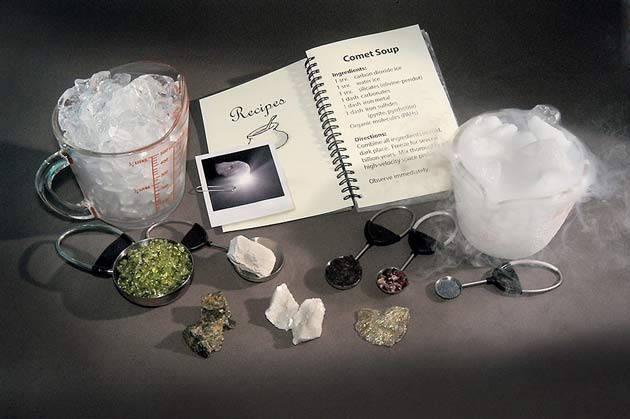Surprises Found in Comet Recipe

Newly analyzed data from NASA's Spitzer Space Telescope details the recipe for comets based on observations of Tempel 1, the object smacked in early July by the Deep Impact probe.
"We are assembling a list of comet ingredients that will be used by other scientists for years to come," said Carey Lisse of Johns Hopkins University's Applied Physics Laboratory.
Spitzer used its infrared cameras to monitor material kicked up by the Deep Impact probe. Earlier this week, other Tempel 1 observations from dozens of telescopes around the world and in space were announced. The upshot: Tempel one is a fluff ball, with more than 50 percent of its contents being grains of water ice. The Spitzer findings expanded on that basic result.
Lisse's team found standard comet components, such as silicate. The astronomers likened the silicate grains to crushed gems, saying they were smaller than typical sand grains.
There were surprises, too, such as clay and carbonates -- the stuff of seashells. These were unexpected because they are thought to require liquid water to form.
"How did clay and carbonates form in frozen comets?" Lisse said in a NASA statement released today. "We don't know, but their presence may imply that the primordial solar system was thoroughly mixed together, allowing material formed near the Sun where water is liquid, and frozen material from out by Uranus and Neptune, to be included in the same body."
Scientists hope now to begin using this new recipe to make better computer models for how the solar system formed. Comet innards - what Spitzer saw - are thought to be pristine leftovers from the formation of the Sun and planets around 4.5 billion years ago.
Get the Space.com Newsletter
Breaking space news, the latest updates on rocket launches, skywatching events and more!
"Now, we can stop guessing at what's inside comets," said Mike A'Hearn, principal investigator for the Deep Impact mission and an astronomer at the University of Maryland. "This information is invaluable for piecing together how our own planets as well as other distant worlds may have formed."
Lisse presented the findings this week at the 37th annual meeting of the Division of Planetary Sciences in Cambridge, England.
- Smashing Science: Deep Impact's Top 10 Images
- Deep Insight: Comet Buster Reveals Dusty Secrets
- Deep Impact Flyby Spacecraft Ready For New Mission
- Deep Impact: Special Report
Join our Space Forums to keep talking space on the latest missions, night sky and more! And if you have a news tip, correction or comment, let us know at: community@space.com.

Rob has been producing internet content since the mid-1990s. He was a writer, editor and Director of Site Operations at Space.com starting in 1999. He served as Managing Editor of LiveScience since its launch in 2004. He then oversaw news operations for the Space.com's then-parent company TechMediaNetwork's growing suite of technology, science and business news sites. Prior to joining the company, Rob was an editor at The Star-Ledger in New Jersey. He has a journalism degree from Humboldt State University in California, is an author and also writes for Medium.









